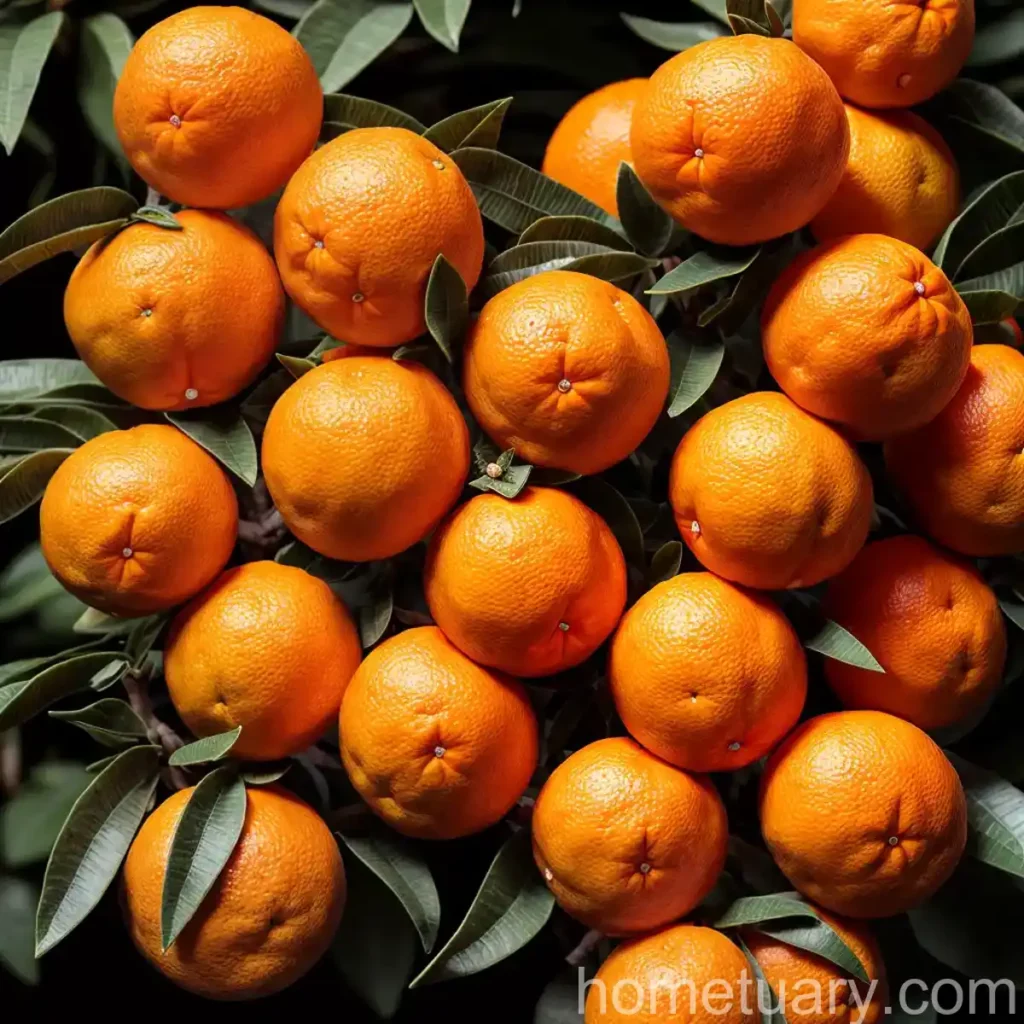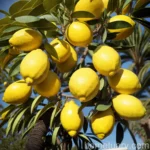The Amazing mandarin orange (Citrus reticulata ‘Clementine’)
Mandarin oranges, such as the ‘Clementine’ variety, are a popular choice for both fruit enthusiasts and professional growers. They are widely appreciated for their sweet taste, vibrant color, and numerous culinary applications. In this comprehensive guide, we’ll delve into the world of the mandarin orange, focusing on the ‘Clementine’ variety, its cultivation, uses, common diseases, and much more.
What is a ‘Clementine’ Mandarin Orange (Citrus reticulata)?
Mandarin orange, scientifically known as Citrus reticulata, is a small, loose-skinned variety of the orange family. The ‘Clementine’ is a specific cultivar of the mandarin orange, characterized by its smooth, glossy appearance, and a delightful balance of sweet and tart flavors.
Key Takeaways – ‘Clementine’ Mandarin Orange (Citrus reticulata)
Let’s take a quick look at the key takeaways before diving into the specifics of growing and caring for ‘Clementine’ mandarin oranges:
- Scientific Name: Citrus reticulata ‘Clementine’
- Common Names: Mandarin orange, Clementine orange
- Features: Smooth, glossy skin; sweet and tart flavor
- Uses: Fresh consumption, juicing, cooking, and garnishing
- Cultivation: Well-drained soil, adequate sunlight, moderate watering, and occasional pruning
- Potential Issues: Susceptible to certain diseases and pests
- Fun Fact: ‘Clementine’ mandarins are a hybrid between a sweet orange and a mandarin, resulting in their unique flavor profile.
Now, let’s proceed to explore the various aspects of ‘Clementine’ mandarin oranges in detail.
Culture
Uses
- Fresh Consumption: The most common use of ‘Clementine’ mandarin oranges is for fresh consumption. Their easy-to-peel skin and juicy segments make them a favorite snack for both children and adults.
- Juicing: Due to their high juice content and balanced flavor, ‘Clementine’ mandarins are often juiced to create refreshingly sweet beverages. Their juice is also used in cocktails and culinary preparations.
- Cooking and Garnishing: The zest and juice of ‘Clementine’ mandarins add a delightful citrusy flavor to a wide range of dishes, including salads, desserts, and savory recipes. Additionally, the segments are often used as a colorful and flavorful garnish.
Growing Conditions
Water
Proper watering is key to the successful cultivation of ‘Clementine’ mandarin oranges. They prefer consistently moist soil, but it is essential to avoid overwatering, which can lead to root rot. During the growing season, water the plants deeply but infrequently, allowing the top layer of soil to dry between waterings. In the winter months, reduce the frequency of watering to prevent waterlogged conditions.
Sunlight
Mandarin oranges, including the ‘Clementine’ variety, thrive in full sun. They require a minimum of 6-8 hours of direct sunlight daily to produce quality fruit. When selecting a planting site, choose a location that receives ample sunlight and offers some protection from strong winds, especially in regions with harsh climates.
Fertilizer
Proper fertilization is essential for the healthy growth and fruit production of ‘Clementine’ mandarin orange trees. Use a balanced fertilizer formulated specifically for citrus trees, applying it according to the manufacturer’s instructions. It is advisable to fertilize young trees every 6-8 weeks during the growing season, while mature trees can be fertilized 3-4 times per year.
Soil
Well-drained soil is crucial for the successful cultivation of ‘Clementine’ mandarin oranges. They thrive in slightly acidic to neutral soil with a pH range of 6.0-7.5. Additionally, they prefer a loamy, fertile soil that is rich in organic matter. If the natural soil conditions are not optimal, consider amending the soil with organic materials such as compost or well-rotted manure to improve its texture and fertility.
Pruning
Regular pruning is essential to maintain the health, shape, and productivity of ‘Clementine’ mandarin orange trees. Pruning activities should focus on removing dead, diseased, or crossing branches, as well as maintaining an open canopy structure to allow adequate sunlight penetration and air circulation. Pruning is typically conducted in late winter or early spring before the trees enter the active growth phase.
Propagation
‘Mandarin orange: Citrus reticulata ‘Clementine’ can be propagated through several methods, including:
-
Seed Propagation: While mandarin oranges can be grown from seeds, the resulting plants may not exhibit the exact characteristics of the parent tree. Additionally, they may take longer to bear fruit, making this method less favorable for commercial growers.
-
Grafting: Grafting onto suitable rootstocks is the preferred method for propagating ‘Clementine’ mandarin oranges, as it ensures the preservation of desirable traits and reduces the time to fruit production. T-budding and side-veneer grafting are commonly used techniques for propagating mandarin orange trees.
Container Cultivation
‘Mandarin orange: Citrus reticulata ‘Clementine’ can be successfully grown in containers, making them a suitable choice for those with limited garden space or for individuals living in colder climates. When cultivating ‘Clementine’ mandarins in containers, it is essential to select a large pot with adequate drainage holes and fill it with a well-draining potting mix formulated for citrus plants. Place the container in a sunny location and provide regular watering and fertilization as per the specific needs of potted citrus plants.
Popularity
Mandarin oranges, especially the ‘Clementine’ variety, have gained tremendous popularity worldwide due to their exquisite taste, convenient size, and versatile applications. Whether consumed fresh, juiced, or used in culinary creations, ‘Clementine’ mandarins are beloved for their juicy, sweet segments and bright aroma.
Common Diseases
While mandarin orange trees are relatively resilient, they are susceptible to certain diseases that can impact their overall health and fruit production. Some common diseases that may affect ‘Clementine’ mandarins include:
- Citrus Canker: A bacterial disease that causes raised, corky lesions on leaves, stems, and fruit. Citrus canker can lead to defoliation and fruit drop, compromising the tree’s vigor.
- Citrus Tristeza Virus (CTV): This viral disease affects the vascular system of citrus trees, leading to symptoms such as leaf cupping, yellowing, and stunted growth. Severe CTV infections can cause tree decline and reduced fruit quality.
- Citrus Greasy Spot: A fungal disease characterized by the appearance of greasy-looking, dark brown lesions on the leaves. It can lead to premature leaf drop and reduced photosynthetic capacity.
Disease Diagnosis
Prompt and accurate diagnosis of potential diseases is crucial for implementing effective management strategies. When observing unusual symptoms on ‘Clementine’ mandarin orange trees, consider the following steps to aid in disease diagnosis:
-
Visual Inspection: Carefully examine the affected plant parts, including leaves, stems, and fruit, for any abnormal symptoms such as discoloration, lesions, or unusual textures.
-
Laboratory Testing: In cases of uncertain diagnosis, seek professional assistance from plant pathologists or agricultural extension services to conduct specialized laboratory tests, including pathogen isolation, serological assays, and molecular analyses.
-
Symptom Comparison: Compare the observed symptoms with known disease profiles and characteristic symptom expressions to narrow down the potential causes of the issue.
Common Pests
‘Mandarin orange: Citrus reticulata ‘Clementine’ can be targeted by various pests that can compromise the health and productivity of the trees. Some common pests that may affect ‘Clementine’ mandarins include:
- Asian Citrus Psyllid (Diaphorina citri): This insect vectors the bacterium Candidatus Liberibacter asiaticus, which causes the devastating citrus greening disease. Early detection and management of Asian citrus psyllids are crucial for preventing the spread of this destructive pathogen.
- Citrus Leaf Miner (Phyllocnistis citrella): The larvae of citrus leaf miners tunnel inside the leaves, creating serpentine patterns and causing aesthetic damage to the foliage. While this pest rarely poses a significant threat to the overall health of mature trees, severe infestations can lead to leaf drop and reduced photosynthetic capacity.
Botanist’s Tips
As a botanist specializing in citrus cultivation, here are some valuable tips for successfully growing and caring for ‘Clementine’ mandarin orange trees:
- Prune Wisely: When pruning ‘Clementine’ mandarin oranges, aim to strike a balance between maintaining tree health and promoting fruit-bearing wood. Avoid excessive pruning, especially during the fruiting season, as it can reduce the following year’s yield.
- Monitor Soil Moisture: Regularly monitor the soil moisture levels around ‘Clementine’ mandarin orange trees, especially during hot and dry periods. Adjust the watering frequency based on the plant’s needs, aiming for consistent but not waterlogged soil conditions.
- Integrated Pest Management (IPM): Implement an IPM approach to manage pests and diseases in the orchard. This strategy emphasizes the use of cultural, biological, and chemical control measures in a balanced and environmentally friendly manner.
Fun Facts
To round off our exploration of ‘Clementine’ mandarin oranges, here are some intriguing fun facts about this delightful citrus fruit:
- Did you know that the ‘Clementine’ mandarin is named after Father Clement Rodier, who is credited with discovering the variety in the garden of an Algerian orphanage in the early 20th century?
- ‘Clementine’ mandarins are often referred to as “Christmas oranges” due to their peak season coinciding with the holiday season, making them a popular choice for festive decorations and culinary preparations.
Links to External Resources
For additional information on ‘Clementine’ mandarin oranges, citrus cultivation, and related topics, explore the following external resources:
- University of California Agricultural and Natural Resources – Citrus Variety Collection
- University of Florida IFAS Extension – Citrus Growing Guide
- Citrus Research and Education Center, University of Florida
- USDA National Agricultural Library – Citrus Production and Marketing
- University of Arizona Cooperative Extension – Citrus Pest Management
Conclusion
In conclusion, ‘Clementine’ mandarin oranges, with their delectable flavor, vibrant color, and versatile uses, are a wonderful addition to any home garden or commercial orchard. By providing the appropriate cultural care, monitoring for potential issues, and implementing sound horticultural practices, you can enjoy a bountiful harvest of these delicious fruits while admiring the beauty of the ‘Clementine’ mandarin orange tree.
Remember to explore the provided external resources for further in-depth insights and guidance on citrus cultivation, and embrace the joy of growing, caring for, and savoring the bounty of ‘Clementine’ mandarin oranges.















